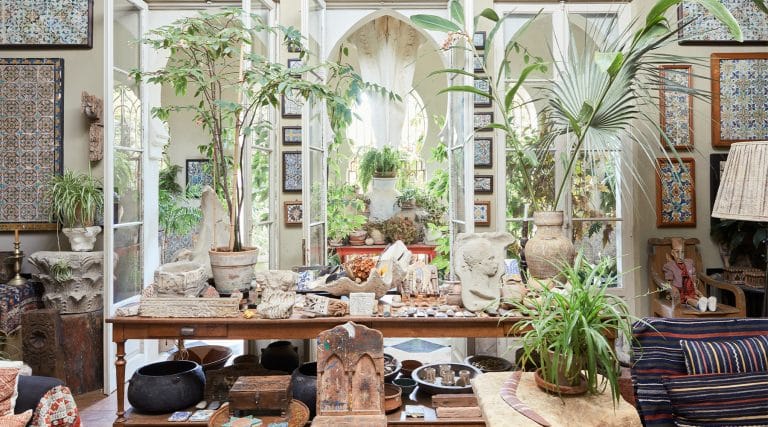
April 3, 2013“I’ve written two books trying to pinpoint the magic of the city, and I think it’s just that — magic,” says Debra Shriver, senior vice president of Hearst (photo by David Tompkins). Top: Shriver designed her dining room chairs, which feature scenes in toile of the founding of New Orleans (photo by Susan Sully from Stealing Magnolias).
Debra Shriver is a dynamo, and that’s no exaggeration. She knows precisely when to turn the heat up high (even though her husband, Jerry, a longtime editor at USA Today, does most of the cooking) and when to turn it down to a simmer. That’s a handy talent to have for someone who is senior vice president and chief communications officer of the Hearst Corporation.
When Shriver began her stint at the huge, privately held media company in 1996, her role was to handle the publicity for all of Hearst’s magazines (15 at the time). Today, her purview has expanded exponentially, now encompassing not only a much larger magazine division — 19 titles in the U.S. alone — but all of Hearst’s newspaper, television and Internet holdings too, including various joint ventures. A great deal of her time is spent cultivating news, dodging bullets and putting out fires — a tricky balancing act. But Shriver does it with remarkable ease and aplomb.
For a woman accustomed to subtleties, it’s curious that her preferred color scheme is black and white. You rarely see her dressed in anything else. Perhaps it’s the absolutes that appeal to her. She also prefers black-and-white movies from the 1930s — the films of “The Thin Man” series and early Hitchcock are among her favorites — and she collects vintage black-and-white photographs by the likes of Elliott Erwitt, Walker Evans, Lillian Bassman, Cecil Beaton, Horst P. Horst and Richard Avedon.
Shriver has, however, written two remarkably colorful books about her beloved adopted city. Her first, Stealing Magnolias: Tales from a New Orleans Courtyard (Glitterati, 2010), tells the saga of buying and restoring a house there shortly after Hurricane Katrina. Her latest, In the Spirit of New Orleans, published by Assouline, establishes Shriver as the go-to-gal for all things New Orleans.

Bourbon Street at night from In the Spirit of New Orleans. Photo © Russell Kord/kordcoimages.com
Shriver’s personal enthusiasms are many — jazz, the arts, French culture, preservation, philanthropy and food, glorious food — and no place on the planet combines and satisfies those enthusiasms more than New Orleans.
After Hurricane Katrina swept through the region in 2005, at exactly the moment when many citizens were fleeing to parts unknown, the Shrivers made the ultimate commitment and bought an 1830s Greek Revival home in the French Quarter, one of the only areas spared from the catastrophic flooding that devastated so much of the city.
Proceeding undeterred and apace, the Shrivers began to build a life there (albeit on weekends and holidays while living in New York during the week). They made friends, became involved in the community — Shriver is a national trustee of the New Orleans Museum of Art and a presidential advisor to New Orleans’s Preservation Resource Center — and continue to help ongoing efforts to revitalize the city.
In the Spirit of New Orleans was a natural fit for Shriver, who has wholeheartedly embraced all things of the Crescent City, whether dressing in costume for Mardi Gras; attending the annual music festival, Jazzfest; club-hopping over a weekend; binging on all manner of oysters, beignets and jambalaya; downing Sazeracs and Ramos Gin Fizzes; and rooting for the New Orleans Saints.
Recently Introspective contributor Pamela Fiori, a longtime friend of Shriver’s and a former Hearst colleague as the editor of Town & Country, spoke to Shriver about her new book and the ineffable magic of the Big Easy.

For the front parlor of her New Orleans home, Shriver purchased nearly everything on Magazine Street, including this chair from 1stdibs dealer Maison de Provence. Photo by Susan Sully from Stealing Magnolias (Glitterati)
You were born and bred in Alabama and now live in New York City. Why did you choose New Orleans as your second home and what was your “aha” moment in clinching that decision?
Thank you for not starting with the question, “How’d a girl from a small town in Alabama get to New York City . . . ?” This still happens quite a lot, and I always answer: “A jet. And you?”
I love the title line from Willie Morris’s book North Toward Home. It means that if you’re a Southerner, you live out this big arc in life, which takes you north, then home south again. I’ve always embraced Southern food, customs, music and literature and have “taken it” with me all these years. But the time came when I wanted a footprint — a house, really — down South.
New Orleans seduced me years ago. It felt like home: the seafood-rich cuisine, the sweeping gestures of hospitality, the familiar Gulf Coast winds, the balmy climate. I even like the humidity; I call it “embraceable air.”
Through the years, we developed many close friendships with locals, but I wanted more. I wanted a stake in the ground that said, “This is home.”
I was curious about all aspects of New Orleans. Even before Katrina, I became a student of the city — not only of its food, music and history but also the idiosyncrasies that resulted from the mixing of many cultures over time. By this, I mean the phrases used to describe things (“making groceries” for shopping); the way streets are mispronounced on purpose; the old-fashioned custom of dropping off thank-you notes by hand (they appear miraculously in the mail slot; the person who wrote them would never bother you by knocking on the door).
So much of my research and observations filled up the pages of both books. The first, Stealing Magnolias, is a memoir of finding our house. The second, In the Spirit of New Orleans, is a celebration of a lively, rambunctious city that embraces its own culture and rallied up from its knees post-Katrina.

Friends hanging out in the French Quarter. The city’s oldest neighborhood is where Shriver has her second home. Photo from In the Spirit of New Orleans ©Cedric Angeles
Your house is smack in the middle of the French Quarter. What are the pros and cons of being in the center of the action?
We chose the French Quarter because it is a walker’s paradise. It’s urban yet historic. Each street is a string of period architecture consisting of sun-washed cottages and Greek Revival townhouses. The streets are lined with brick sidewalks and wrought-iron fences that wrap around courtyard gardens. Every little errand run becomes a historic walking tour.
The French Quarter today is a real neighborhood. My day begins with a short walk for the newspapers and a French boule. If the weather allows, I spend mornings reading in my courtyard. The commercial Quarter is a series of little shops: the pâtisserie, the florist, the bookstore. There are cafes, bars and restaurants. Neighbors open their homes to entertain. Cocktails and dinner parties are a big part of the social scene.
How did your two books on New Orleans come about, and why did you get Wynton Marsalis to write the foreword?
I had an early, brief career in journalism and have always worked with editors, but I never tackled a book. I created an outline one evening and had a book contract two days later. The second book happened just as fast. I loved learning and writing about my favorite topic.
Wynton is a favorite son of the city, that’s for sure, and like Louis Armstrong before him, he is the consummate ambassador of jazz. Beyond being a performer and showman, he’s an educator who understands the meaning of jazz — its improvisational teachings, its democracy and why it could only come from a place like New Orleans.
You and your husband, Jerry, are ardent foodies and jazz fans. Please share some of your favorite restaurants, chefs and clubs.
The best trick for visiting New Orleans is to mix the traditional with the new. Have a drink at the Monteleone’s historic Carousel Bar, but stop by Cure or Bar Tonique to sample artisanal cocktails. Make reservations at Commander’s Palace, in the Garden District, but be sure to visit the new Creole saloon SoBou (short for South of Bourbon). For music, hit Frenchmen Street and Tipitina’s, but cruise Irvin Mayfield’s Jazz Playhouse. Tried, true and new.

Shriver acquired this desk and chair from Lars Bolander. The photograph of Ella Fitzgerald performing at the New Orleans Jazz and Heritage Festival is by the local photographer Steven Forster. Photo by Susan Sully from Stealing Magnolias
New Orleans has much more to it than great music. What else about it appeals to you and why?
Someone asked the actor John Goodman the same question recently and he said, “The air carries music.” I’ve written two books trying to pinpoint the magic of the city, and I think it’s just that — magic. I can give you dozens of reasons why New Orleans is a special place, but it’s hard to point to just one. When was the last time you danced with masked strangers? Or attended a garden party with a full orchestra on the lawn — given in your honor by someone you’ve never met? Or drank Champagne cocktails in the front parlor with five gentlemen, all in white tie and tails? Or made jam out of kumquats from a neighbor’s tree, picked and given to you by passersby? Or caught painted and glittered coconuts tossed from a street parade? These are the things that happen in New Orleans.
And then there is what I call “invisible scenery” — jazz sounds, tugboat cries, steamboat whistles, calliopes, the clopping of horses pulling French Quarter carriages, the pie lady selling her pies, the smell of jasmine and sweet olive wafting from overhead branches. It’s the layering of sound and scent over what the eye can actually see.
I started the first book with a simple quote from the writer Roald Dahl: “And above all, watch with glistening eyes the whole world around you because the greatest secrets are always hidden in the most unlikely places. Those who don’t believe in the magic will never find it.” Seems I have found it.
Purchase These Books
Stealing Magnolias | In The Spirit of New Orleans










